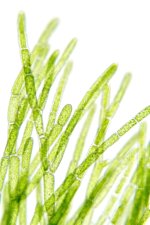Brightfield Microscopy
Uses & Advancements; Microscope Reviews; Pros and Cons
Brightfield microscopy is the most elementary form of microscope illumination techniques and is generally used with compound microscopes.
The name "brightfield" is derived from the fact that the specimen is dark and contrasted by the surrounding bright viewing field. Simple light microscopes are sometimes referred to as brightfield microscopes.
How it Works
In brightfield microscopy a specimen is placed on the stage of the microscope and incandescent light from the microscope’s light source is aimed at a lens beneath the specimen. This lens is called a condenser.

Featured right: Algae under the microscope with visible cells using brightfield illumination.
The condenser usually contains an aperture diaphragm to control and focus light on the specimen; light passes through the specimen and then is collected by an objective lens situated in a turret above the stage.
The objective magnifies the light and transmits it to an oracular lens or eyepiece and into the user’s eyes. Some of the light is absorbed by stains, pigmentation, or dense areas of the sample and this contrast allows you to see the specimen.
For good results with this microscopic technique, the microscope should have a light source that can provide intense illumination necessary at high magnifications and lower light levels for lower magnifications.
Uses and Advancements
To some extent, brightfield microscopy is used in most disciplines requiring microscopic investigation.
Because it is a simple method, this is the first type of microscopy students learn in schools.
The life sciences, particularly microbiology and bacteriology, have always relied on the brightfield technique.
This technique can be used to view fixed specimens or live cells. Since many organic specimens are transparent or opaque, staining is required to cause the contrast that allows them to be visible under the microscope.
Different stains and staining techniques are used depending upon the type of specimen and cell structure being examined.
For example:
- Fuchsin is used to stain smooth muscle cells
- Methylene blue is used to stain cell nuclei
- Gram stain is used on bacteria and gives rise to the name gram-negative or gram-positive bacteria based on the reaction of the bacteria to the stain. In fact, many scientific journals will not accept microbiological research for publication that is not supported by gram staining and brightfield illumination methodology. Most routine medical microscopic examination of blood and tissue is performed using this illumination technique.
Different complimentary techniques can be used to augment brightfield microscopy. By using a polarizing filter this illumination technique can be used in geological microscopic research and will reveal details not visible using white light.
Properly stained, microorganisms may be magnified to 1200x; utilizing an oil immersion objective will increase resolution at this high magnification.
Digital Imaging Options
Although a basic method of microscopy, brightfield as a technique is well suited to mating with new technologies.
Digital imaging systems can make high resolution images of properly stained microorganisms using this technique.
Three-dimensional imaging accessories can be used with the brightfield method and newer technologies will allow real time viewing in 3D.
Also suited to video imaging, this enhancement will allow the user to view motile organisms interacting with their environment.
Brightfield technique has been mated with cell imaging software to better perform tasks previously delegated to fluorescence microscopy. By using multiple focal levels the cell borders and nuclei can be located in cell populations.
The benefit of using brightfield illumination for this task is that it frees fluorescent channels in microscopes and eliminates distortions caused by the overlapping of the color emissions of the stains and the excitation of the fluorescing materials.
Here's a related article and interesting software for digital imaging applying digital colour brightness and true colour 3D.
Advantages
Brightfield microscopy is very simple to use with fewer adjustments needed to be made to view specimens.
Some specimens can be viewed without staining and the optics used in the brightfield technique don’t alter the color of the specimen.
It is adaptable with new technology and optional pieces of equipment can be implemented with brightfield illumination to give versatility in the tasks it can perform.
Disadvantages
Certain disadvantages are inherent in any optical imaging technique.
- By using an aperture diaphragm for contrast, past a certain point, greater contrast adds distortion. However, employing an iris diaphragm will help compensate for this problem.
- Brightfield microscopy can’t be used to observe living specimens of bacteria, although when using fixed specimens, bacteria have an optimum viewing magnification of 1000x.
Brightfield microscopy has very low contrast and most cells absolutely have to be stained to be seen; staining may introduce extraneous details into the specimen that should not be present.
Also, the user will need to be knowledgeable in proper staining techniques.
Lastly, this method requires a strong light source for high magnification applications and intense lighting can produce heat that will damage specimens or kill living microorganisms.
Check out many more useful microscopy imaging techniques here.
Great Microscopes to Consider...
OMAX 40X-2500X Brighter Darkfield LED Trinocular Compound Microscope with 9MP Digital Camera
AmScope T490A-PCT Compound Trinocular Microscope with Phase Contrast turret
Return from Brightfield Microscopy to Compound Light Microscope
Return to Best Microscope Home
Find out how to advertise on MicroscopeMaster!




